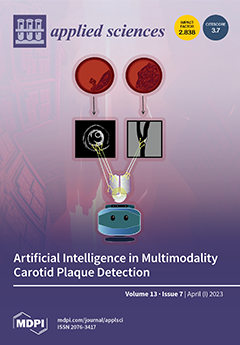The first detailed selected reagent ion-time-of-flight-mass spectrometric fundamental investigations of 2,6-diisopropylphenol, more commonly known as propofol (C
12H
18O), and its metabolite 2,6-diisopropyl-1,4-benzoquinone (C
12H
16O
2) using the reagent ions H
3O
+, H
3
[...] Read more.
The first detailed selected reagent ion-time-of-flight-mass spectrometric fundamental investigations of 2,6-diisopropylphenol, more commonly known as propofol (C
12H
18O), and its metabolite 2,6-diisopropyl-1,4-benzoquinone (C
12H
16O
2) using the reagent ions H
3O
+, H
3O
+.H
2O, O
2+• and NO
+ are reported. Protonated propofol is the dominant product ion resulting from the reaction of H
3O
+ with propofol up to a reduced electric field strength (
E/N) of about 170 Td. After 170 Td, collision-induced dissociation leads to protonated 2-(1-methylethyl)-phenol (C
9H
13O
+), resulting from the elimination of C
3H
6 from protonated propofol. A sequential loss of C
3H
6 from C
9H
13O
+ also through collision-induced processes leads to protonated phenol (C
6H
7O
+), which becomes the dominant ionic species at
E/N values exceeding 170 Td. H
3O
+.H
2O does not react with propofol via a proton transfer process. This is in agreement with our calculated proton affinity of propofol being 770 kJ mol
−1. Both O
2+• and NO
+ react with propofol via a charge transfer process leading to two product ions, C
12H
18O
+ (resulting from non-dissociative charge transfer) and C
11H
15O
+ that results from the elimination of one of the methyl groups from C
12H
18O
+. This dissociative pathway is more pronounced for O
2+• than for NO
+ throughout the
E/N range investigated (approximately 60–210 Td), which reflects the higher recombination energy of O
2+• (12.07 eV) compared to that of NO
+ (9.3 eV), and hence the higher internal energy deposited into the singly charged propofol. Of the four reagent ions investigated, only H
3O
+ and H
3O
+.H
2O react with 2,6-diisopropyl-1,4-benzoquinone, resulting in only the protonated parent at all
E/N values investigated. The fundamental ion-molecule studies reported here provide underpinning information that is of use for the development of soft chemical ionisation mass spectrometric analytical techniques to monitor propofol and its major metabolite in the breath. The detection of propofol in breath has potential applications for determining propofol blood concentrations during surgery and for elucidating metabolic processes in real time.
Full article





